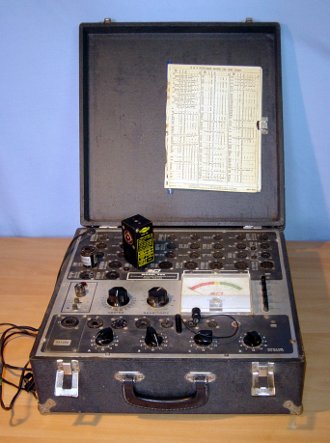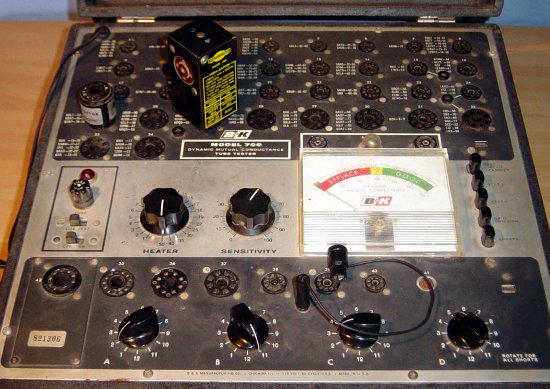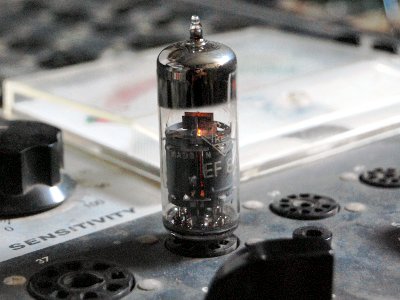B&K model 700 tube tester

After years of hesitation, I finally decided to buy a tube tester.
The B&K model 700 I bought through E-bay is a modern tube tester that allows
quick set-up of gm tests for many modern valves.
My tester is in decent shape.
After callibration, I had reasonable results, though I have a suspicion
that even after callibration it reads too low.
The B&K 700 is an American tube tester from about 1965.
It contains two tubes of itself:
- Type 83 mercury vapour rectifier as plate voltage rectifier;
- 6BN8 dual diode + triode for grid voltage, screen voltage and amplifier
for leak and gas tests.
The types that are tested in the pre-wired sockets in the
“Dyna-Quick” section, are tested for gm (mutual conductance)
and the test circuit is optimised for the type of valve.
In the lower section, one can test “other” types of valves, by
setting the connections using a number of switches.
But as I found out, the valves in the lower section
only get an emission test.
The reason why I bought this type of tester was that it is affordable.
There is really a hype building around tube testers, driving prices up.
Really good tube testers such as those from Neuberger, AVO and Funke,
have become very expensive, sometimes even surpassing their original retail price!
The B&K 700 is among the types that (according to documentation,
opinions and reviews found on Internet)
will perform a gm (mutual conductance) test, and give good results.
I bought it through Ebay in August 2008 and had it sent to me from
the US through the mail.
After a few weeks it arrived, no damage and in the condition the seller
had promised.
I tried it and was able to test a few boxes of old valves mainly from
TV sets and weed out the bad ones.
But not all valves could be tested satisfactorily.
First, I kept having my doubts about the results in the lower section.
The percentage of valves rejected there was lower than in the
“Dyna-Quick” sockets. So was that test reliable?
Secondly, I had a number of valves for which no settings or sockets were
available.
Thirdly, after testing a few hundred valves,
I felt a need to have a tester that I could understand better and make
more settings, even though that meant that I would have a harder job
finding the right settings.
And lastly, because many valves read a bit low, I suspect that one or both
of the rectifier valves are weak.
But I'd need a second tube tester to find that out.
So I'll need another tube tester.
This is why I bought a
Hickok I-177 tester a few months later.
That one will allow me to test older types, while it is possible to
extend it with other sockets and set it for tests of other valves.



